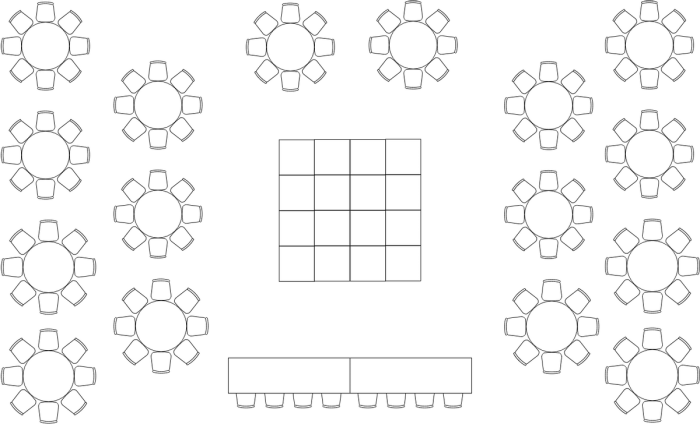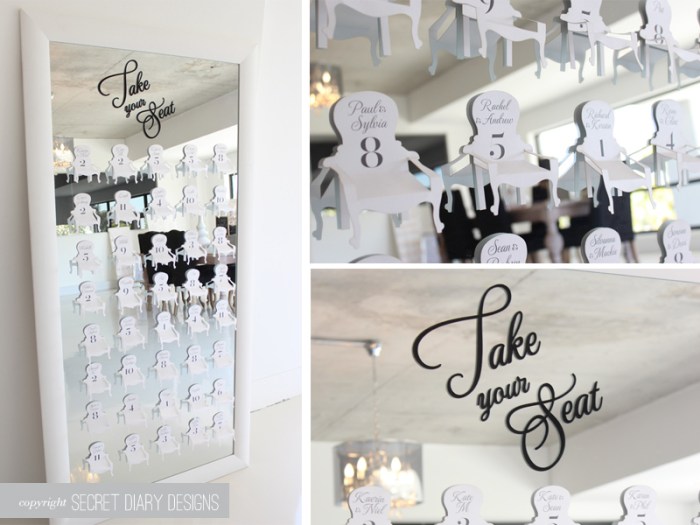From intimate gatherings to grand events, seating plans play a crucial role in shaping the ambiance and functionality of any space. Seating plan ideas encompass a myriad of considerations, ranging from innovative seating arrangements and ergonomic solutions to space optimization techniques and thematic designs.
This comprehensive guide delves into the art of creating seating plans that are both visually appealing and practical, ensuring a comfortable and memorable experience for guests.
Whether you’re planning a wedding, corporate event, or simply seeking to optimize your home’s layout, this guide provides valuable insights and practical tips to help you create seating plans that seamlessly blend style and function.
Creative Seating Arrangements

When it comes to seating arrangements, there’s no need to stick to the ordinary. Innovative and unconventional seating ideas can add personality and style to any space.From unique chair designs to unconventional layout patterns, there are endless possibilities for creating seating arrangements that are both functional and visually appealing.
Whether you’re looking to create a cozy and inviting atmosphere or a more formal and sophisticated one, there’s a creative seating arrangement that’s perfect for you.
Unique Chair Designs
One of the easiest ways to add personality to your seating arrangement is to choose unique and stylish chairs. There are endless possibilities when it comes to chair design, so you’re sure to find something that fits your taste and style.-
- –
- Oversized chairs:Oversized chairs are a great way to add a touch of luxury and comfort to your seating arrangement. They’re perfect for sinking into after a long day or curling up with a good book. –
- Egg chairs:Egg chairs are a classic design that’s always in style. They’re perfect for creating a cozy and inviting atmosphere in any room. –
- Hanging chairs:Hanging chairs are a fun and unique way to add seating to your space. They’re perfect for relaxing and enjoying the outdoors. –
- Beanbag chairs:Beanbag chairs are a great way to add a touch of casual comfort to your seating arrangement. They’re perfect for lounging around and watching TV or reading a book. –
- Chaise lounges:Chaise lounges are a great way to add a touch of sophistication to your seating arrangement. They’re perfect for relaxing and taking a nap.
Unconventional Layout Patterns
In addition to choosing unique chairs, you can also create a more interesting seating arrangement by using unconventional layout patterns.-
- –
- Circular seating:Circular seating is a great way to create a more intimate and inviting atmosphere. It’s perfect for small groups of people who want to be able to talk and interact easily. –
- Asymmetrical seating:Asymmetrical seating is a great way to add a touch of visual interest to your seating arrangement. It’s perfect for creating a more dynamic and modern look. –
- Multi-level seating:Multi-level seating is a great way to add a touch of drama to your seating arrangement. It’s perfect for creating a more sophisticated and formal look. –
- Outdoor seating:Outdoor seating is a great way to enjoy the outdoors and create a more relaxed and casual atmosphere. It’s perfect for parties, barbecues, and other social gatherings.
Ergonomic Seating Solutions
Ergonomic seating solutions are designed to provide comfort, support, and reduce strain while sitting for extended periods. They are essential for maintaining good posture, reducing the risk of musculoskeletal disorders, and improving productivity.Investing in ergonomic seating solutions is a wise choice for both individuals and businesses.
Not only does it promote employee well-being, but it can also reduce absenteeism, improve morale, and increase productivity.
Chair Recommendations, Seating plan ideas
When choosing an ergonomic chair, consider the following features:
- Adjustable seat height and depth
- Lumbar support
- Contoured seat cushion
- Breathable fabric
- Five-star base with casters
Desk Recommendations
An ergonomic desk should provide ample workspace and allow for proper posture. Consider desks with the following features:
- Adjustable height
- Spacious work surface
- Keyboard tray
- Monitor arm
- Cable management system
Accessories
Ergonomic accessories can further enhance comfort and reduce strain. Consider the following:
- Footrest
- Back support cushion
- Wrist rest
- Anti-fatigue mat
- Standing desk converter
Space Optimization Techniques

Maximizing seating capacity in limited spaces is crucial for accommodating more guests or attendees without compromising comfort. Here are some strategies to achieve optimal space utilization:
Utilizing Tables and Benches:
- Rectangular tables seat more people than round tables, as they allow for guests to sit along the lengthier sides.
- Benches provide efficient seating along walls or under tables, allowing for additional seating without taking up too much floor space.
Multi-Purpose Furniture:
- Ottomans with built-in storage can serve as extra seating while providing a place to store blankets or other items.
- Nesting tables can be stacked or arranged to create more space when not in use, while providing additional seating when needed.
Thematic Seating Arrangements
Thematic seating arrangements elevate events by creating an immersive atmosphere that aligns with the occasion’s theme or concept. By incorporating specific colors, patterns, and decorative elements, these arrangements enhance the overall experience and leave a lasting impression on guests.
Color Schemes
Colors play a vital role in setting the tone and ambiance of an event. For a vibrant and energetic atmosphere, choose bold hues like red, orange, or yellow. For a more sophisticated and elegant setting, opt for neutral tones like black, white, or gray, accented with metallics or jewel tones.
Pattern Play
Patterns add visual interest and can be used to create a cohesive look. Incorporate geometric patterns for a modern and edgy vibe, or opt for floral patterns for a touch of elegance. Stripes and polka dots are also popular choices that can be adapted to various themes.
Decorative Touches
Decorative elements such as candles, flowers, and centerpieces add the finishing touches to thematic seating arrangements. Choose candles with scents that complement the theme, and arrange flowers in vases that match the color scheme. Centerpieces can be customized to reflect the event’s concept, such as miniature replicas of iconic landmarks or abstract sculptures.
Crowd Management Considerations
Crowd management is essential for ensuring the safety and comfort of attendees at any event. When planning a seating plan, it’s crucial to consider how to manage the flow of people effectively.
Here are some key principles to keep in mind:
- Anticipate the size and demographics of the crowd.This will help you determine the appropriate seating capacity and layout.
- Create a clear and concise seating plan.Make sure it’s easy for attendees to find their seats and avoid confusion.
- Provide ample space for movement.This will help prevent overcrowding and allow attendees to move around freely.
- Identify potential bottlenecks and plan for them.This could involve creating additional entrances or exits, or widening aisles.
- Have a plan in place for emergencies.This could include evacuation routes and designated meeting points.
By following these principles, you can create a seating plan that will help ensure a smooth and safe event for all attendees.
Accessibility and Inclusivity
Ensuring accessibility and inclusivity in seating arrangements is paramount to creating a welcoming and comfortable environment for all guests. This means considering the needs of individuals with disabilities, including wheelchair users, the elderly, and those with sensory sensitivities.
To accommodate wheelchair users, provide ample space for movement and ensure accessible pathways to the seating area. Consider providing designated wheelchair-accessible seating with unobstructed views of the event.
Assistive Devices
- Provide accessible seating for individuals with mobility aids, such as walkers or canes.
- Consider offering seating with armrests or lumbar support for those with limited mobility.
- Provide clear signage and wayfinding cues to assist guests with sensory impairments in locating seating areas.
Sensory Considerations
- For individuals with hearing impairments, provide seating near assistive listening devices or interpreters.
- For those with visual impairments, ensure seating with clear sightlines and consider providing audio descriptions or large-print materials.
- Minimize noise and distractions for guests with sensory sensitivities by creating designated quiet zones or offering noise-canceling headphones.
By implementing these accessibility and inclusivity measures, event organizers can ensure that all guests feel welcome and accommodated, creating a truly inclusive and enjoyable experience for all.
Technology Integration

In the digital age, technology offers a myriad of opportunities to enhance seating plans. Online reservation systems allow guests to book their seats in advance, ensuring a hassle-free experience.
Interactive seating charts provide a visual representation of the venue, enabling guests to select their preferred seats with ease. Real-time updates keep attendees informed of any changes or adjustments to the seating arrangement.
Mobile Apps
- Allow guests to reserve seats and check-in using their smartphones.
- Provide access to interactive seating charts and real-time updates.
- Facilitate communication between attendees and event organizers.
Virtual Reality
- Offers a virtual tour of the venue, allowing guests to preview seating options.
- Helps guests visualize the event space and make informed seating decisions.
- Enhances the overall guest experience by providing an immersive preview.
Visual Representation
Visual representation of seating arrangements is crucial for effective planning and communication. Here’s a table summarizing different arrangements with images and explanations.
Table of Seating Arrangements
| Arrangement | Image | Description | Advantages | Disadvantages |
|---|---|---|---|---|
| Theatre Style | [Image of theatre-style seating] | Rows of chairs facing a central stage or speaker. | – Clear view for all attendees
|
– Limited interaction
|
| Classroom Style | [Image of classroom-style seating] | Rows of desks or tables with chairs facing a whiteboard or projector. | – Promotes note-taking and learning
|
– Can be cramped
|
| U-Shape Style | [Image of U-shape seating] | Chairs arranged in a U-shape, facing inward. | – Fosters discussion and collaboration
|
– Can be difficult to accommodate large groups
|
| Roundtable Style | [Image of roundtable seating] | Chairs arranged around a circular table. | – Promotes equality and participation
|
– Can be noisy and distracting
|
| Banquet Style | [Image of banquet-style seating] | Long tables with chairs on both sides. | – Accommodates large groups
|
– Limited interaction between attendees
|
Real-World Examples
Explore case studies and successful seating plans implemented in various events and spaces. Analyze their key factors and how they can be adapted to different situations.
Case Study: Royal Albert Hall
- Tiered seating design optimizes sightlines and acoustics.
- Flexible seating arrangements accommodate different event types and capacities.
- Designated wheelchair-accessible areas ensure inclusivity.
Example: Google I/O Conference
- Open and flexible seating layout encourages collaboration and networking.
- Color-coded seating sections facilitate easy navigation and crowd management.
- Integrated technology allows attendees to access event information and connect with speakers.
Closing Notes: Seating Plan Ideas
In conclusion, seating plan ideas extend far beyond mere arrangements of chairs and tables. They represent an opportunity to enhance the overall experience of any event or space. By incorporating creativity, ergonomics, and inclusivity, you can create seating plans that not only meet practical needs but also leave a lasting impression on your guests.
Remember, a well-planned seating arrangement can transform any gathering into an unforgettable occasion.
Commonly Asked Questions
What are some unique seating ideas for small spaces?
Consider using benches, ottomans, or bean bags to maximize seating capacity while creating a cozy and informal atmosphere.
How can I create a seating plan that accommodates guests with disabilities?
Ensure there are accessible pathways, designated seating areas, and adequate space for wheelchairs or mobility aids.
What are some tips for crowd management in seating plans?
Plan for smooth flow of attendees, avoid overcrowding by leaving ample space between seating areas, and consider using crowd barriers or ushers to guide guests.


